







| Great Spotted Woodpecker (Dendrocopos major (Linnaeus, 1758)) |








|
|
Scientific name: Dendrocopos major (Linnaeus, 1758) Common name: Great Spotted Woodpecker French name: Pic épeiche Order: Piciformes Family: Picidae Size: 22 to 23 cm, 70 to 90 g. Habitat: You can see this Woodpecker in any place where there are trees. It lives in parks, orchards, woodlands and large forests. Food: This Woodpecker feeds on insects it finds moving along trunk and branches. It also feeds on seeds (mainly conifers), on fruits and can also attack broods. Nesting: Woodpeckers chisel out holes in trunks, with a depth of about 30cm. Females lay 4 to 6 eggs. The male and the female are taking turns to sit on the eggs. Migration: Sedentary, the lack of pine-cones in winter can cause northern birds to move southwards. Geographic area: All Europe except extreme northern Scandinavia. North of Asia except extreme northern areas. |
The Great Spotted Woodpecker is the most common woodpecker. It is black and white, the abdomen and the under tail are bright red. The male has a square-shaped red patch on the nape while the top of the female's head is completely black. Two fingers stand forwards while two fingers stand backwards. With strong curved claws, they enable woodpeckers to quickly move along trunks. The stiff tail's feathers are acting as support. It drums much more often than other Woodpeckers, especially in early spring to mark its territory. |
| [To know more about the Great Spotted Woodpecker] [Next picture] [Top] |
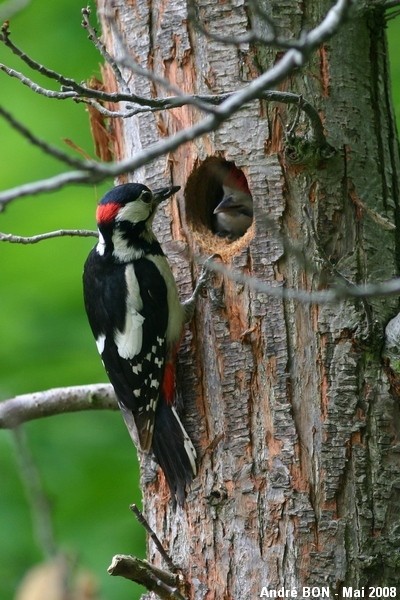
|
There are plenty of Great Spotted Woodpecker in the forests near Paris. You just need to locate a nest to shoot some pictures, taking usual care as it is not good to annoy birds during the nesting period. |
| [To know more about the Great Spotted Woodpecker] [Next picture] [Previous picture] [Top] |
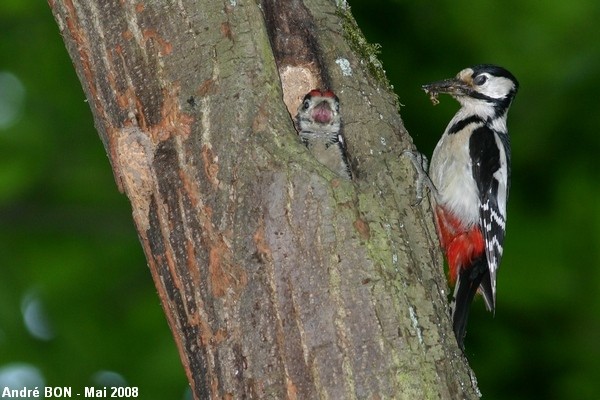
|
Great Spotted Woodpecker chicks are very noisy. I have located this nest by hearing them screeching. I had to use the flash because of the dense foliage. I will buy a second flash in the near future. This one will allow me to light the scene on a different axis. This second flash, configured in slave mode, will be automatically controlled by the master flash plugged on top of the camera. The above photo suffers from too direct lighting. |
| [To know more about the Great Spotted Woodpecker] [Next picture] [Previous picture] [Top] |
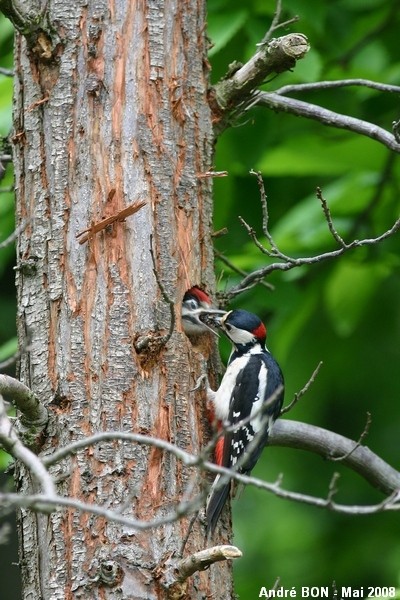
|
Among the four nests observed in 2008, this one was really the better located to take pictures. Its location near a forest track and the south orientation were providing very good light conditions. By experience, a rudimentary camouflage was enough. Adults came to the nest without being annoyed by my presence. They come with a beak full of insects and larvae about every 10 minutes (I have observed much longer times with Green Woodpeckers). |
| [To know more about the Great Spotted Woodpecker] [Next picture] [Previous picture] [Top] |
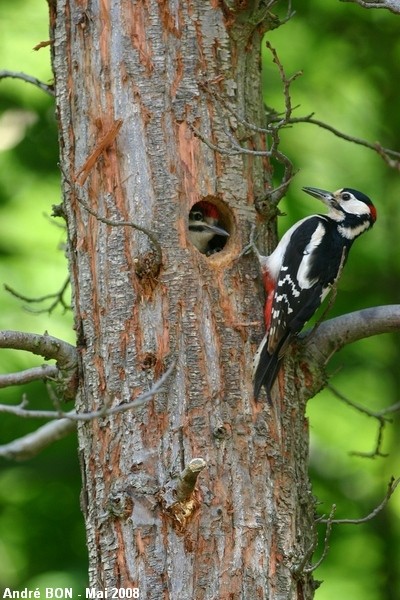
|
I have been able to shoot a complete series of pictures. The selection will be difficult. |
| [To know more about the Great Spotted Woodpecker] [Next picture] [Previous picture] [Top] |
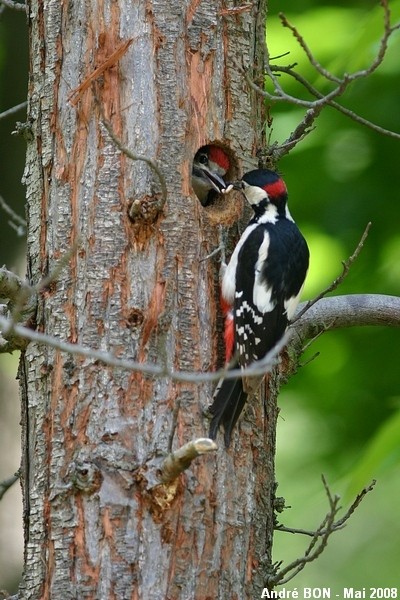
|
I have noticed that my pictures only show the male coming to the nest with a beak full of insects or larvae. This means that the female is worried by my presence and stay at distance. You always need to question yourself on how you disturb animals when you want to shoot pictures. And you need to move away quickly when you think that the disturbance is too high. |
| [To know more about the Great Spotted Woodpecker] [Next picture] [Previous picture] [Top] |
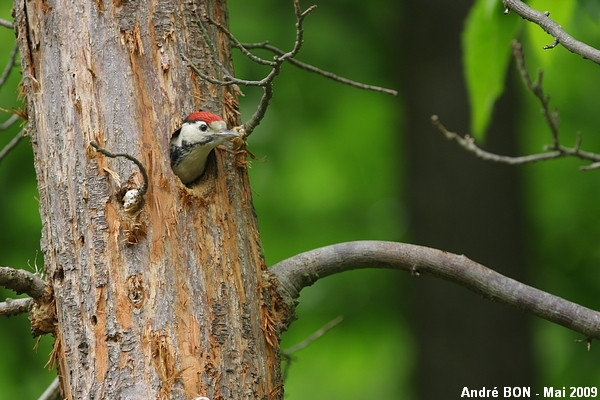
|
The nest observed in 2008 has been reused in 2009. It is difficult to know how many young birds grow in this nest. They had to take their turn so that each curious head gets out to see my camera and my tripod. |
| [To know more about the Great Spotted Woodpecker] [Next picture] [Previous picture] [Top] |
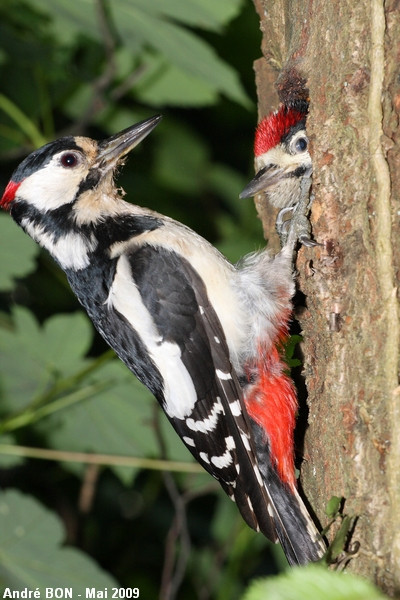
|
I have found this nest by hearing the continuous calls of the chicks. It was located under a shrub on a woodland edge at a relatively low height, about one meter and thirty centimetres from the ground. You would have to lean down in order to have a look at the inside of the nest. I haven't done this not to frighten the brood. I have shot this picture using a radio-frequency remote control. The tripod was too close to the nest, then giving a too tight view. |
| [To know more about the Great Spotted Woodpecker] [Previous picture] [Top] |
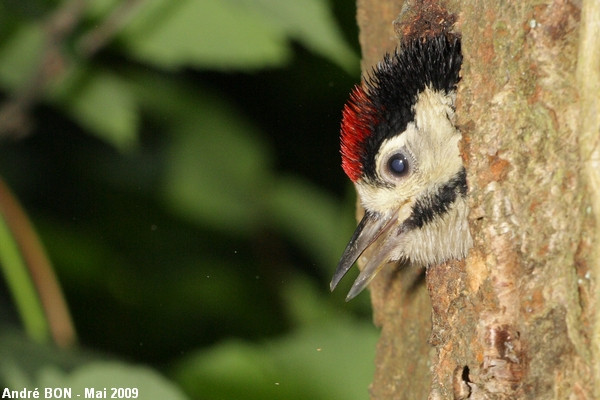
|
It is easy to shoot close-up views with such a low nest. The use of the flash light was mandatory because of the shadow of the dense vegetation. |